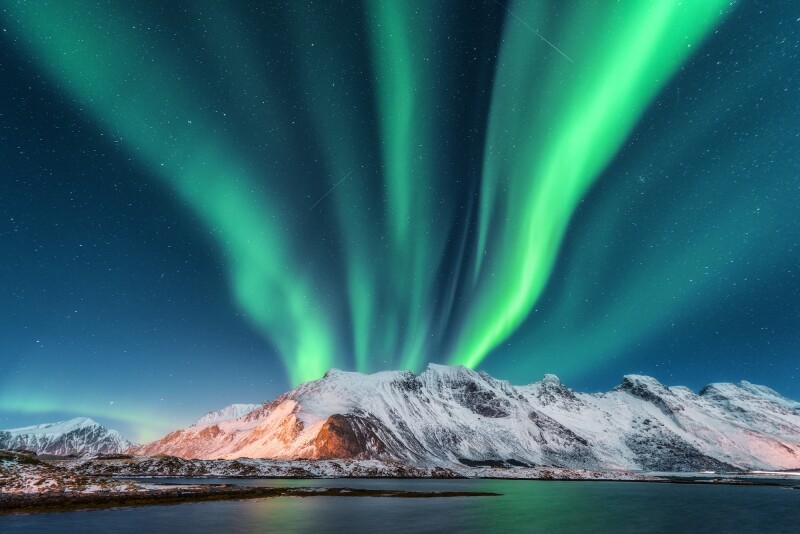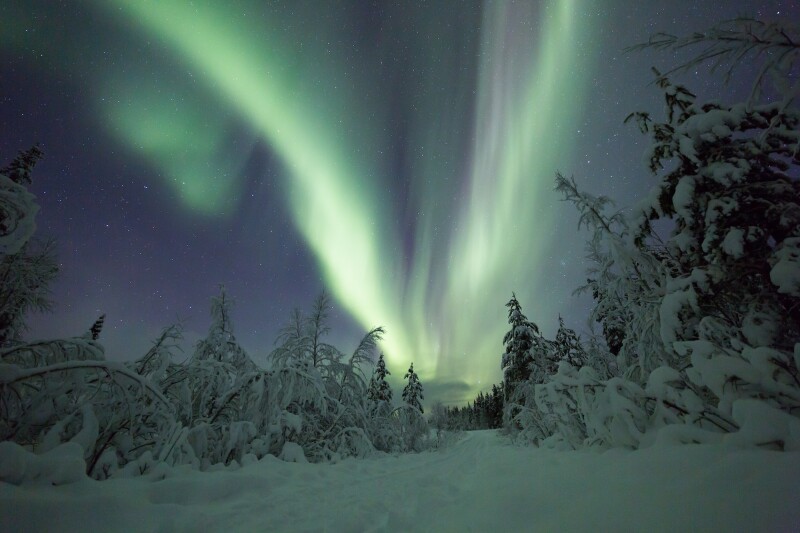The Northern Lights are among nature’s most spectacular displays. The celestial phenomenon, also known as the aurora borealis, occurs when electrically charged solar particles collide with atmospheric gases to produce a dazzling neon light show that illuminates the night sky.
Even experts can’t always predict exactly when and where the lights can be seen, but your best bet for catching them is during winter in these high-latitude polar regions. Here are the best places to see the Northern Lights—and how to experience them.

Fairbanks, Alaska, is considered one of the best places in the world to see the Northern Lights.
Photo by Marc Schiffhauer/Shutterstock
Alaska
In Alaska, Fairbanks is a popular hub for Northern Lights tourism thanks to its international airport and its prime position under the “aurora oval”—a ring-shaped zone that hugs the northernmost climes where aurora activity is concentrated. The tourism board estimates that aurora is visible in Fairbanks four out of five nights, provided the sky is clear. From here, you can also catch a bush plane (Northern Alaska Tour Company has daily flights) to Coldfoot, Alaska, an isolated community in the foothills of the Brooks Range. It’s north of the Arctic Circle and doesn’t have any light pollution to compete with the solar show.
How to go
From Fairbanks, 1st Alaska Tours run a variety of runs of aurora viewing trips each evening, including visits to Chena Hot Springs (one of the best hot springs in the United States), to Murphy Dome (a good viewing point just outside of town), and to the Arctic Circle. From $110 per person
Where to stay: Borealis Basecamp
Located in a rural area 45 minutes north of Fairbanks, this property, set within 100 acres of boreal forest, has two types of accommodations: private fiberglass igloos with see-through ceilings and cubes, where the north-facing wall is floor-to-ceiling window. In either, you can view the Northern Lights.

The Yellowknife area in Canada’s Northwest Territories is located directly beneath the aurora oval.
Photo by Ken Phung/Shutterstock
Canada
Many parts of northern Canada witness the aurora borealis regularly, but the extremely remote Yukon and Northwest Territories are some of the top spots to see the natural light show—they’re visible up to 240 days per year.
How to go
At Aurora Village—an Aboriginal-owned and operated gathering of 21 tepees surrounding a frozen lake—guests who book the three-night viewing package have an estimated 98 percent chance of seeing the aurora at least once, according to the tour operator. (Guests actually stay at a hotel in nearby Yellowknife and receive nightly transportation to Aurora Village for Northern Lights viewing.) From about $250 per person for three-night tour
Where to stay: Blachford Lake Lodge
To get to this wilderness resort, you’ll need to fly in. It’s a 25-minute bush plane ride from Yellowknife. It’s a fairly private outpost, with just five individual cabins and five rooms within the lodge for guests. During the day, guests can go snowmobiling, cross-country skiing, hiking, or enjoy the hot tub.

Norway’s long and dark winter nights provide clear skies for optimal aurora viewing.
Photo by Denis Belitsky/Shutterstock
Norway
Sitting at 69° North in the center of the aurora zone (and above the Arctic Circle), Tromsø is one of northern Norway’s most popular destinations for aurora viewing. Or for the really daring, the remote Svalbard archipelago (found about 600 miles north of mainland Norway) offers the opportunity to see polar bears, Arctic foxes, and reindeer in addition to the Northern Lights.
How to go
Sail through Arctic fjords while searching for the Northern Lights on a 14-day cruise with Hurtigruten Expeditions (from $5,080 per person) or embark on a one-day adventure led by a Sámi guide to meet reindeer, eat traditional food, and scan the skies for the aurora borealis (from $181 per person with Get Your Guide).
Where to stay: Tromsø Ice Domes Hotel
Because it’s located just outside of Tromsø’s city limits, you won’t need to worry about light pollution—though you should bring an extra set of long underwear, as the accommodations are literal igloos that are remade each winter. Guests are given sleeping bags and reindeer skins to sleep on.

Even though the Northern Lights occur year-round in Greenland, they can’t be seen during summer due to the midnight sun.
Photo by Yongyut Kumsri/Shutterstock
Greenland
Most of Greenland lies within the Arctic Circle, making it a prime location for spotting the Northern Lights. The small town of Kangerlussuaq hosts an international airport where most travelers arrive on the island and is also situated right in the middle of the area where the aurora borealis is best experienced.
How to go
Each year from November through March, Greenland Tours offers a five-day Northern Lights and Icebergs adventure around Ilulissat in Disko Bay that can include snowshoeing, dog sledding, and aurora viewing along the famous ice fjord. From about $1,050 per person.
Where to stay: Hotel Arctic
Found on the edge of the Ilulissat Ice Fjord (a UNESCO World Heritage site), with views of the bay, this hotel has 90 rooms ranging from singles to suites (some of which have private terraces for watching the solar show).

The Northern Lights are visible on about 200 nights a year in Finnish Lapland.
Photo by Jamen Percy/Shutterstock
Finland
In Lapland, Finland’s sparsely populated northern region bordering Sweden, Norway, and Russia, the Northern Lights are visible on roughly 200 nights of the year thanks to very minimal light pollution.
How to go
Nordic Adventures offers a slew of Northern Lights viewing excursions, including photography tours, snowmobile safaris, nighttime reindeer sleigh rides, and aurora hunting from private Finnish tipi tents. From $105 per person
Where to stay: Arctic TreeHouse Hotel
Arctic TreeHouse Hotel has three accommodation options: the Arctic TreeHouse Suites (stilted cabins with floor-to-ceiling windows that can sleep up to three), the Arctic GlassHouses (two-bedroom houses that can sleep up to six people and have a kitchenette, fireplace, and private sauna), and the ArcticScene Executive Suite (which features a king-size bed, a “nest bed,” a lounge area, a kitchenette, two bathrooms, and a private sauna, fireplace, and terrace).

In Sweden’s Abisko National Park, low precipitation levels and minimal light pollution mean clearer skies.
Photo by Sheng Feng/Shutterstock
Sweden
Abisko National Park in Sweden has developed a reputation for being one of the world’s top aurora-watching destinations due to its particular microclimate, which sees less precipitation than other locations within the aurora zone, allowing for clearer skies.
How to go
Between October and March, Lights Over Lapland offers specialized, four-hour aurora borealis photo workshops in Abisko National Park. Small groups are provided with high-quality cameras and led by professional photographers who teach basic skills for photographing the Northern Lights (from $145 per person). Alternatively, a three-night Aurora in the Sky package from Off the Map Travel allows guests the chance to search for the Northern Lights on a hot air balloon ride through starry skies.
Where to stay: Tree Hotel
Arguably one of the most distinctive hotels in Sweden, if not Europe, Tree Hotel has eight one-of-a-kind cabins. There’s one shaped like a UFO, another that looks like a massive bird’s nest, and one where the outer walls are made of mirrors, so it reflects and blends into its surroundings.

In Iceland, it’s possible to view an aurora borealis display above the Jökulsárlón glacial lagoon.
Photo by John A. Davis/Shutterstock
Iceland
Iceland’s dramatic landscapes—among them the Snæfelsness peninsula, Jökulsárlón glacial lagoon, and Reynisfjara black-sand beach—are particularly spectacular spots from which to view the Northern Lights. Easily reachable by car from Reykjavík, Thingvellir National Park is another crowd favorite.
How to go
Reykjavik Excursions offers three-hour small group tours each night from late August to April in search of the elusive light dance (from $85 per person). Another option is Icelandair’s Golden Circle and Northern Lights three-day tour, which takes guests to sites like Gullfoss waterfall and Thingvellir National Park by day and in search of the celestial displays by night.
Where to stay: The Buubble Lodge
At the Buubble Lodge (nicknamed the “5 Million Star Hotel”), guests can watch the aurora borealis dance across the sky from within a transparent glamping bubble nestled in the woods outside Reykjavík.
This article originally appeared online in November 2018; it was most recently updated in 2023 to include current information.











